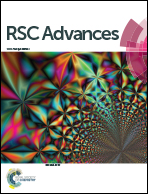Design and preparation of a non-enzymatic hydrogen peroxide sensor based on a novel rigid chain liquid crystalline polymer/reduced graphene oxide composite†
Abstract
A novel non-enzymatic hydrogen peroxide (H2O2) sensor was developed using a rigid chain liquid crystalline (LC) polymer and reduced graphene oxide (rGO) composite. Firstly, we synthesized a novel rigid chain LC polymer with ferrocenyl as the side group. The chemical structures of the monomer and the corresponding polymer were confirmed by 1H NMR, FTIR and 1C NMR. LC behavior of the polymer was investigated by differential scanning calorimetry (DSC) and polarized light microscopy (POM). The electrochemical characterization of the PFECS/rGO films was performed by cyclic voltammetry (CV), electrochemical impedance spectroscopy (EIS), typical amperometric response (IT) measurements. The ferrocenyl in polymer presented excellent electrochemical behavior, and the modified electrode exhibited preferable electrocatalytic activity to the reduction of H2O2. The work revealed that the developed electrochemical sensor detected H2O2 with a higher sensitivity 117.142 μA mM−1 cm−2 and broader linear range between 1 × 10−5 M to 1.9 × 10−4 M.


 Please wait while we load your content...
Please wait while we load your content...